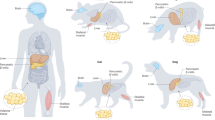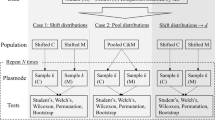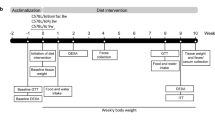Abstract
The mouse is the animal most commonly used to study the underlying causes of and treatments for obesity. The author reviews many of the issues that should be considered by all involved in research with mice expressing this phenotype, and describes some procedures exclusive to obesity research.
This is a preview of subscription content, access via your institution
Access options
Subscribe to this journal
We are sorry, but there is no personal subscription option available for your country.
Buy this article
- Purchase on Springer Link
- Instant access to full article PDF
Prices may be subject to local taxes which are calculated during checkout



Similar content being viewed by others
References
Snyder, E.E. et al. The human obesity gene map: the 2003 update. Obes. Res. 12(3), 369–439 (2004).
Arch, J.R. Lessons in obesity from transgenic animals. J. Endocrinol. Invest. 25(10), 867–875 (2002).
Brockmann, G.A. & Bevova, M.R. Using mouse models to dissect the genetics of obesity. Trends Genet. 18(7), 367–376 (2002).
Mauvais-Jarvis, F., Kulkarni, R.N. & Kahn, C.R. Knockout models are useful tools to dissect the pathophysiology and genetics of insulin resistance. Clin. Endocrinol. (Oxf.) 57(1), 1–9 (2002).
Tschop, M. & Heiman, M.L. Rodent obesity models: an overview. Exp. Clin. Endocrinol. Diabetes 109(6), 307–319 (2001).
Robinson, S.W., Dinulescu, D.M. & Cone, R.D. Genetic models of obesity and energy balance in the mouse. Annu. Rev. Genet. 34, 687–745 (2000).
Beck, B. KO's and organisation of peptidergic feeding behavior mechanisms. Neurosci. Biobehav. Rev. 25(2), 143–158 (2001).
Russell, W.M.S. & Burch, R.L. The Principles of Humane Experimental Technique (Methuen, London, 1959).
Magni, P., Motta, M. & Martini, L. Leptin: a possible link between food intake, energy expenditure, and reproductive function. Regul. Pept. 92(1–3), 51–56 (2000).
Good, D.J., Porter, F.D., Mahon, K.A., Parlow, A.F., Westphal, H. & Kirsch, I.R. Hypogonadism and obesity in mice with a targeted deletion of the Nhlh2 gene. Nat. Genet. 15(4), 397–401 (1997).
Johnson, S.A., Marin-Bivens, C.L., Miele, M., Coyle, C.A., Fissore, R. & Good, D.J. The Nhlh2 transcription factor is required for female sexual behavior and reproductive longevity. Horm. Behav. 46(4), 420–427 (2004).
Institute for Laboratory Animal Research, National Research Council. Guidelines for the Care and Use of Mammals in Neuroscience and Behavioral Research (National Academies Press, Washington, DC, 2003).
Chua, S.C. Jr. et al. Phenotypes of mouse diabetes and rat fatty due to mutations in the OB (leptin) receptor. Science 271(5251), 994–996 (1996).
Lee, G.H. et al. Abnormal splicing of the leptin receptor in diabetic mice. Nature 379(6566), 632–635 (1996).
Chen, H. et al. Evidence that the diabetes gene encodes the leptin receptor: identification of a mutation in the leptin receptor gene in db/db mice. Cell 84(3), 491–495 (1996).
Coleman, D.L. Obese and diabetes: two mutant genes causing diabetes-obesity syndromes in mice. Diabetologia 14(3), 141–148 (1978).
Yamashita, H., Shao, J., Qiao, L., Pagliassotti, M. & Friedman, J.E. Effect of spontaneous gestational diabetes on fetal and postnatal hepatic insulin resistance in Lepr(db/+) mice. Pediatr. Res. 53(3), 411–418 (2003).
Dhar, M.S. et al. Mice heterozygous for Atp10c, a putative amphipath, represent a novel model of obesity and type 2 diabetes. J. Nutr. 134(4), 615–623 (2000).
Yu, S. et al. Paternal versus maternal transmission of a stimulatory G-protein α-subunit knockout produces opposite effects on energy metabolism. J. Clin. Invest. 105(5), 615–623 (2000).
Manser, C.E., Morris, T.H. & Broom, D.M. An investigation into the effects of solid or grid cage flooring on the welfare of laboratory rats. Lab. Anim. 29(4), 353–363 (1995).
Institute of Laboratory Animal Resources, National Research Council. Guide for the Care and Use of Laboratory Animals (National Academy Press, Washington, DC, 1996).
Leiter, E.H. Mice with targeted gene disruptions or gene insertions for diabetes research: problems, pitfalls, and potential solutions. Diabetologia 45(3), 296–308 (2002).
Zochodne, D.W., Murray, M.M., van der Sloot, P. & Riopelle, R.J. Distal tibial mononeuropathy in diabetic and nondiabetic rats reared on wire cages: an experimental entrapment neuropthy. Brain Res. 698(1–2), 130–136 (1995).
Ader, D.N., Johnson, S.B., Huang, S.W. & Riley, W.J. Group size, cage shelf level, and emotionality in non-obese diabetic mice: impact on onset and incidence of IDDM. Psychosom. Med. 53(3), 313–321 (1991).
Nagy, T.R., Krzywanski, D., Li, J., Meleth, S. & Desmond, R. Effect of group vs. single housing on phenotypic variance in C57BL/6J mice. Obes. Res. 10(5), 412–415 (2002).
Leiter, E.H. Control of spontaneous glucose intolerance, hyperinsulinemia, and islet hyperplasia in nonobese C3H.SW male mice by Y-linked locus and adrenal gland. Metabolism 37(7), 689–696 (1988).
Van Loo, P.L., Van de Weerd, H.A., Van Zutphen, L.F. & Baumans, V. Preference for social contact versus environmental enrichment in male laboratory mice. Lab. Anim. 38(2), 178–188 (2004).
Borer, K.T., Pryor, A., Conn, C.A., Bonna, R. & Kielb, M. Group housing accelerates growth and induces obesity in adult hamsters. Am. J. Physiol. 255(1 Pt 2), R128–133 (1988).
Greenman, D.L., Bryant, P., Kodell, R.L. & Sheldon, W. Relationship of mouse body weight and food consumption/wastage to cage shelf level. Lab. Anim. Sci. 33(6), 555–558 (1983).
Trayhurn, P. & James, W.P. Thermoregulation and non-shivering thermogenesis in the genetically obese (ob/ob) mouse. Pflugers Arch. 373(2), 189–193 (1978).
Trayhurn, P. Thermoregulation in the diabetic-obese (db/db) mouse. The role of non-shivering thermogenesis in energy balance. Pflugers Arch. 380(3), 227–232 (1979).
Trayhurn, P. & Fuller, L. The development of obesity in genetically diabetic-obese (db/db) mice pair-fed with lean siblings. The importance of thermoregulatory thermogenesis. Diabetologia 19(2), 148–153 (1980).
Augustsson, H., van de Weerd, H.A., Kruitwagen, C.L. & Baumans, V. Effect of enrichment on variation and results in the light/dark test. Lab. Anim. 37(4), 328–340 (2003).
Naveilhan, P., Canals, J.M., Valjakka, A., Vartiainen, J., Arenas, E. & Ernfors, P. Neuropeptide Y alters sedation through a hypothalamic Y1-mediated mechanism. Eur. J. Neurosci. 13(12), 2241–2246 (2001).
Naveilhan, P., Canals, J.M., Arenas, E. & Ernfors, P. Distinct roles of the Y1 and Y2 receptors on neuropeptide Y-induced sensitization to sedation. J. Neurochem. 78(6), 1201–1207 (2001).
Kushi, A., Sasai, H., Koizumi, H., Takeda, N., Yokoyama, M. & Nakamura, M. Obesity and mild hyperinsulinemia found in neuropeptide Y-Y1 receptor-deficient mice. Proc. Natl. Acad. Sci. USA 95(26), 15659–15664 (1998).
Naveilhan, P. et al. Normal feeding behavior, body weight and leptin response require the neuropeptide Y Y2 receptor. Nat. Med. 5(10), 1188–1193 (1999).
Kohn, D.F. Anesthesia and Analgesia in Laboratory Animals (Academic Press, San Diego, 1997).
Morton, D.B. A systematic approach for establishing humane endpoints. ILAR J. 41(2), 80–86 (2000).
Sieber, F.E. & Traystman, R.J. Ethical issues involved in the development of animal models for type 1 diabetes. ILAR J. 35(1), (1993).
O'Donnell, C.P., Tandersley, C.G., Polotsky, V.P., Schwartz, A.R. & Smith, P.L. Leptin, obesity, and respiratory function. Respir. Physiol. 119(2–3), 163–170 (2000).
Hall, J.E., Brans, M.W., Hildebrandt, D.A. & Mizelle, H.L. Obesity-associated hypertension. Hyperinsulinemia and renal mechanisms. Hypertension 19(1 Suppl), I45–55 (1992).
Coyle, C.A., Jing, E., Hosmer, T., Powers, J.B., Wade, G. & Good, D.J. Reduced voluntary activity precedes adult-onset obesity in Nhlh2 knockout mice. Physiol. Behav. 77(2–3), 387–402 (2002).
Rajala, M.W. et al. Regulation of resistin expression and circulating levels in obesity, diabetes, and fasting. Diabetes 53(7), 1671–1679 (2004).
Makimura, H., Mizuno, T.M., Isoda, F., Beasley, J., Silverstein, J.H. & Mobbs, C.V. Role of glucocorticoids in mediating effects of fasting and diabetes on hypothalamic gene expression. BMC Physiol. 3(1), 5 (2003).
Dubuc, P.U., Cahn, P.J., Ristimaki, S. & Willis, P.L. Starvation and age effects on glycoregulation and hormone levels of C57BL/6J ob/ob mice. Horm. Metab. Res. 14(10), 532–535 (1982).
Maglich, J.M., Watson, J., McMillen, P.J., Goodwin, B., Willson, T.M. & Moore, J.T. The nuclear receptor CAR is a regulator of thyroid hormone metabolism during caloric restriction. J. Biol. Chem. 279(19), 19832–19838 (2004).
Gao, J., Ghibaudi, L. & Hwa, J.J. Selective activation of central NPY Y1 vs. Y5 receptor elicits hyperinsulinemia via distinct mechanisms. Am. J. Physiol. Endocrinol. Metab. 287(4), E706–711 (2004).
Overton, J.M. & Williams, T.D. Behavioral and physiologic responses to caloric restriction in mice. Physiol. Behav. 81(5), 749–754 (2004).
Lowell, B.B. & Bachman, E.S. β-Adrenergic receptors, diet-induced thermogenesis, and obesity. J. Biol. Chem. 278(32), 29385–29388 (2003).
Cabanac, A. & Briese, E. Handling elevates the colonic temperature of mice. Physiol. Behav. 51(1), 95–98 (1992).
Zethof, T.J., Van der Heyden, J.A., Tolboom, J.T. & Olivier, B. Stress-induced hyperthermia in mice: a methodological study. Physiol. Behav. 55(1), 109–115 (1994).
Jimenez, M. et al. β(1)/β(2)/β(3)-adrenoceptor knockout mice are obese and cold-sensitive but have normal lipolytic responses to fasting. FEBS Lett. 530(1–3), 37–40 (2002).
Chen, H.C., Ladha, Z., Smith, S.J. & Farese, R.V., Jr. Analysis of energy expenditure at different ambient temperatures in mice lacking DGAT1. Am. J. Physiol. Endocrinol. Metab. 284(1), E213–218 (2003).
Webb, G.P., Jagot, S.A. & Jakobson, M.E. Fasting-induced torpor in Mus musculus and its implications in the use of murine models for human obesity studies. Comp. Biochem. Physiol. A. 72(1), 211–219 (1982).
Ste Marie, L., Miura, G.I., Marsh, D.J., Yagaloff, K. & Palmiter, R.D. A metabolic defect promotes obesity in mice lacking melanocortin-4 receptors. Proc. Natl. Acad. Sci. USA 97(22), 12339–12344 (2000).
Dauncey, M.J. & Brown, D. Role of activity-induced thermogenesis in twenty-four hour energy expenditure of lean and genetically obese (ob/ob) mice. Q. J. Exp. Physiol. 72(4), 549–559 (1987).
Holmes, B. & Dohm, G.L. Regulation of GLUT4 gene expression during exercise. Med. Sci. Sports Exerc. 36(7), 1202–1206 (2004).
Lerman, I. et al. Genetic variability in forced and voluntary endurance exercise performance in seven inbred mouse strains. J. Appl. Physiol. 92(6), 2245–2255 (2002).
Bouthegourd, J.C., Martin, J.C., Gripois, D., Roseau, S., Tome, D. & Even, P.C. Fat-depleted CLA-treated mice enter torpor after a short period of fasting. Appetite 42(1), 91–98 (2004).
Faldt, J., Wernstedt, I., Fitzgerald, S.M., Wallenius, K., Bergstrom, G. & Jansson, J.O. Reduced exercise endurance in interleukin-6-deficient mice. Endocrinology 145(6), 2680–2686 (2004).
Animal Welfare Act as Amended (7 USC, 2131–2139).
9 CFR 3.8.
Acknowledgements
The author would like to thank Christopher A. Coyle, Franc-Eric A. Wiedmer, and Hilary Woodcock for careful reading of the manuscript and helpful suggestions. This work was supported by grants from the US National Institutes of Health (R01 DK59903, R03 HD42499, and P30 DK46200).
Author information
Authors and Affiliations
Corresponding author
Rights and permissions
About this article
Cite this article
Good, D. Using Obese Mouse Models in Research: Special Considerations for IACUC Members, Animal Care Technicians, and Researchers. Lab Anim 34, 30–37 (2005). https://doi.org/10.1038/laban0205-30
Received:
Accepted:
Issue Date:
DOI: https://doi.org/10.1038/laban0205-30



